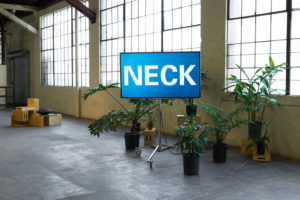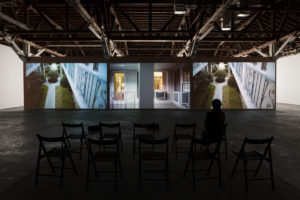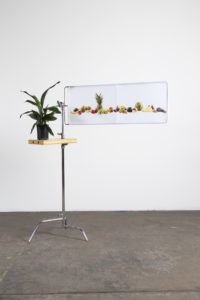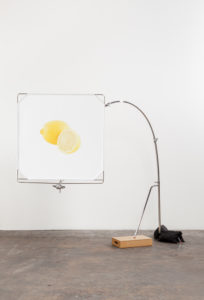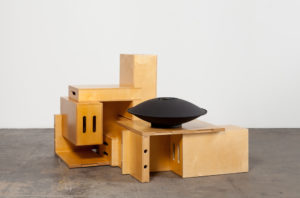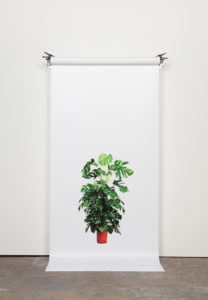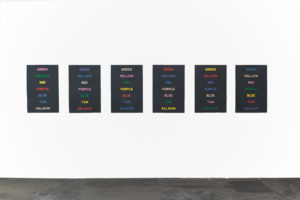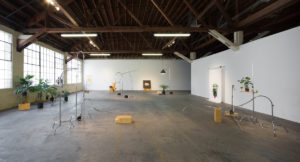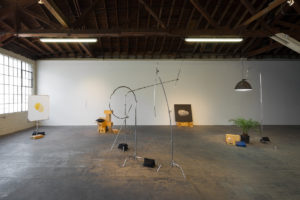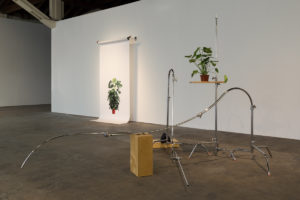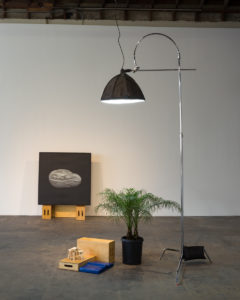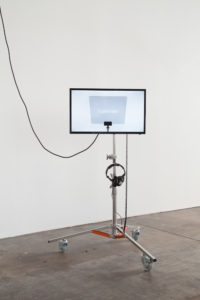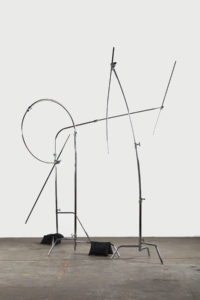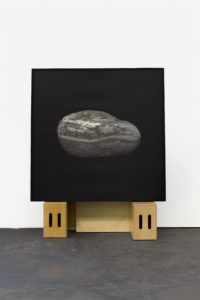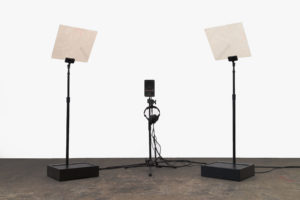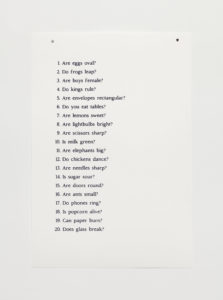Kerry Tribe: The Loste Note
- Kerry Tribe in conversation with Rita Gonzalez, April 2015
Conducted on the occasion of Kerry Tribe’s solo exhibition at 356 Mission.
Rita Gonzalez: I was thinking about the video installation “The Aphasia Poetry Club” in relationship to a larger history of imaging cognitive disorders that is—for the most part—not such a positive one, in particular the attempts of documentary filmmakers. I was wondering if you came into this project thinking about that history or wanting to take that history on.
Kerry Tribe: I didn’t come into the project thinking about that history, exactly. I mean, that’s not what was motivating me. It started as an inquiry into what an interview-based first person documentary about people with aphasia could feel like — a kind of oxymoronic starting point for a film, right? To people who have a hard time talking about having a hard time talking. I always knew the film would have a clear relationship to documentary, and I knew it could raise ethical issues about informed consent, and speaking on behalf of the other, that sort of thing. But things changed once I met my subjects and started filming.
The Aphasia Poetry Club has three narrators: Laura, Chris (the photographer), and Dale (the Vietnam Vet turned movie producer) and you never see any of them… well, you see Laura’s brain scans. But I originally videotaped five people, Chris and Dale among them—a two camera shoot, sort of Charlie Rose aesthetic. By that point I had been attending the Aphasia Support Group at Cedars for many months—maybe a year. I had come to know and really like everyone I was shooting, and I liked what I shot. But when I started showing the footage to people the primary response was extreme discomfort and pity! I don’t know what it was about seeing them but the response seemed to provoke a kind of painful…
RG: Pathos?
KT: Yes, a painful sort of pathos. And that was a shock to me. Because I knew my subjects and didn’t feel that way about them at all. I’d chosen these subjects because they were unique and interesting and communicative in ways that were subtle and beautiful. Anyway, I was surprised. And I realized that what I wanted to do was not this very flat, single channel talking head piece, but a much more subtle and complex “picture” of my subjects and their experiences through a relationship of image and sound. Basically, how they looked on screen had nothing to do with what I was interested in about them. Once I abandoned the idea of pictorially representing them, it freed me up to record many hours of interviews as audio only, and from there to try to invent a kind of language through imagery and editing that felt more specifically adaptable to each person’s character, interests, and personal narrative. I wanted to see how cinematic tropes that were not related to first person direct address could be used to produce experiences for a viewer akin to what these subjects were experiencing in their struggle to produce language. So like Dale has a fluent form of aphasia. He can talk a lot but the wrong things come out—wonderful invented words sometimes —and he speaks agrammatically.. Tracking shots that took full advantage of the width of our super-long frame felt like an appropriate form for that. Laura, on the other hand, tends to restate ideas in different ways before feeling like she understands what she herself is saying. So her imagery kind of mirrors that pattern, as does her sound design.
RG: With Laura, in terms of cinematic references, I think more of your connection to experimental film and Hollis Frampton whose interest in repetition and vocalization you’ve reworked in “Critical Mass.” In the segments with Laura, she has this kind of recursive speech which you play off of through use of the repeated image.
KT: Frampton’s “Zorns Lemma” would be a great example of that kind of coding of images in a structural-linguistic fashion. He used the alphabet as a starting point to code imagery, and you begin to cognitively associate each image with a letter. So there’s this process of substitution you naturally develop. You are learning a language as you learn the piece, as you watch the piece. I love that. And I think that’s a really good model for someone like Laura.
RG: And then there’s animation. What did animation open up for you as someone who has really engaged more with documentary practices?
KT: I’ve done a little work in animation before but the motivation here was all about Dale. Dale has been on a quest to make a children’s animated cartoon for decades but ever since a stroke left him aphasic he can’t get any of his former colleagues in the industry to take him seriously. I was interested in Dale and he was equally interested in me because I was an artist and filmmaker and he thought he might be able to team up with me to finally realize this project.
RG: He had years in Hollywood, as a scriptwriter and producer?
KT: It’s hard to tell exactly, but I know Dale worked in the production department on some big films—Rocky and its sequels, Raging Bull. And at some point he developed this vision of a wonderful land where innocent creatures who couldn’t communicate because they couldn’t get organized enough to communicate could work together and through community produce this beautiful music. And of course this sounded so autobiographical to me! Like the community Dale had found through the Aphasia Support Group and the Aphasia Book Club were a salve for his troubled mind. All of these things he would say about having to be very, very quiet in Vietnam, and not speaking Vietnamese but developing this tenderness for the children he met there under the worst possible circumstances… I wanted to see if we could use Dale’s vision for this world and his experience in the jungles of Vietnam as two poles in his representation. You know? So he says “I was in S.E.A.L.” and suddenly his character turns from a Canary to a Seal. To be able to really make that physical for him in a way that was both playful but also gave an image to the wonderful way he has of expressing himself felt like the right fit. Not like I think of Dale as the first audience for this film or anything, but the relationships I have with each of the three subjects in the film is by now quite rich and complex. It was at some level really important to me to be making representations that I felt they would be comfortable with, embrace, and allow them to tell their story in a way that they otherwise couldn’t.
RG: At the end of the video, Laura is comparing the challenges of representation as an aphasic, with that of an artist. The artist’s attempt to communicate an idea through a form or concept as a struggle…
KT: The idea that you know what you want to make but you just don’t know how to get there.
RG: Yeah!
KT: You know it but you can’t get there! That’s how I felt. When I was with the group, it became clear to me that part of the pleasure that I was getting each week, of why I kept coming back, was seeing, albeit a very different struggle, but a struggle I could relate to! As an artist, tying to figure out how to get that thing out of your head and into the world–how to communicate. How to represent. I never expected that to happen.
RG: I was thinking about the space of language, of visualizing language. In the past, your work has been more about the challenges of communicating memory and where one locates oneself in relationship to a larger historical narrative. That happens in the piece, and I think in particular it’s interesting the connection of Chris and Dale to Vietnam and Cambodia. There’s this traumatic memory that somehow then becomes fused with the process of relearning how to communicate and relearning how one makes sense in the world, and also make sense of the world.
KT: That’s something I struggled with in this project because the project began as an exploration of aphasia and ended as a portrait of three people that, I wouldn’t say they just happen to have aphasia, but it’s not really what their stories are about. It was only very late in the editing process that the Chris’s 1996 photo project about the Killing Fields in Cambodia settled into place as kind of the climax of his narrative. I went back and forth, back and forth, about how explicit to make that. In the effort to try and keep history out of it—this is a project about aphasia, it’s not a project about Vietnam, it’s not a project about Cambodia, right? Those would be big red herrings. I thought if I went there I was going to throw people off, make it too confusing, raise to many questions. But it’s not a project about aphasia, it’s a project about people and people live in history and history is lived through people and so for each of these people they have their history and that speaks. I mean, if I have as one subject Chris, an artist who grew up in the 1970s, and Dale, an American man in his late 60s, it’s not surprising that they have these stories to tell.
I also think in earlier works I’ve made, there’s been a kind of circular looping structure where one keeps coming back again and again to some kind of site of perceived trauma. I’m thinking of the earliest works like “The Audition Tapes” where there’s apparently some kind of history of familial abuse but you never quite know what it is and all these different actors try to get to it and no one gets to it and they say the wrong words. In a way, this project is sort of about trying to find a way to represent absence or loss.
What happens if you focus on that loss of language and see what can start to percolate up into its space? I think that’s what Chris was trying to do in his project about Cambodia. Chris and a collaborator bascially discovered an archive of photographs of people who had been murdered by the Khmer Rouge. They discovered this in Cambodia and worked very hard to retouch the photographs, have them published and see that the photographs would be accessible to surviving family members for identification and memorialization. It’s an amazing project. It came out in 1996 or 97. At the same time I was in college making “FAMILY / MEMORY / ROUGH / CUTS” which was almost entirely black with white text and audio interviews with my mother about her senile father. In that piece, there are similar tropes of trying to picture loss and negation as something that could hold a space. How do you picture that non-space, that non-existance? A lot of the work in this show is trying to do that. Maybe it’s not a direct answer to the question about history, but if we’re driven to get back to some site of completion it’s often paradoxically through negation. The death drive, you know? You try to get somewhere but in getting there you find that it’s not where you think you are. You miss your object of desire and come up with something else.
RG: I think it’s interesting too with the sculptural, photographic, and other video components. There is, again like in the film, a way in which you’re bringing in a kind of reflexivity through a transparent mode of production. But you also found a way to objectify speech and also found a way to use the kind of, I don’t want this to sound like I’m romanticizing aphasia but you’ve also found a way to think rhizomatically…
KT: I wouldn’t go so far as to say I romanticize aphasia…
RG: No, I don’t think you do.
KT: But I would say, and this set me up as a target of criticism, that what I’ve found in my relationship with these three people as well as a lot of other people with various forms of aphasia (of course no two people with aphasia have the exact same disability) but almost universally the people I’ve met with aphasia have developed a reconstituted, powerful other kind of communication skill set that was not in place before their disability, before their brain damage, regardless of its cause. My friend Susan who moderates the support group jokes that I’ve learned to “speak aphasic.” To me at least, this new communicative style is mindful and poetic and often speaks better than the language I’m used to. For example, around the studio, we talk about things being “lost in the blither.” That’s something that Dale says. I don’t think I included it in the final cut, but it’s so perfect! Sometimes a thought just gets lost in the blither. You know exactly what that means. There’s a moment in the film where Dale does these sort of sound effects to go along with the jungle footage that I shot at 356. His sound effects are totally great and somehow better than any jungle sound effects we might come up with. There’s a kind of… with aphais, there is a deficit to be sure, but also there are assets. Something is gained. In each of these three subjects you will see something that so many people with aphasia who I’ve met have: a kind of optimism. A game-ness. Granted I’ve met a self-selecting group of aphasics who find the groups helpful and keep coming back for more. There are a lot of people with aphasia out there who don’t have the support and treatment and therapy they desperately need. But with that support the aphasic community I’ve come to know have discovered gifts in their disability that they never would’ve anticipated and that other people probably wouldn’t imagine.
- Select ReviewsPast Press
-
Kids Day inspired by Kerry Tribe’s exhibition “The Loste Note”
May 17, 2015

